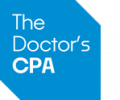Every year, thousands of physicians unintentionally “tip” the IRS, often by tens of thousands of dollars. The reason isn’t carelessness; it’s complexity.
As a locum tenens or 1099 physician, your income, deductions, and filing requirements look nothing like those of a W-2 employee. Yet many doctors use cookie-cutter tax services or outdated advice, missing valuable deductions and strategies that could dramatically reduce their tax bills.
In this guide, we explore the most common mistakes physicians make and how to fix them through smart, proactive tax planning. By understanding where most doctors go wrong and how to avoid these pitfalls, you can keep more of what you earn while staying fully compliant with tax laws.
Top 7 Tax Mistakes Physicians Make (and How to Fix Them)
Mistake 1: Failing To Plan For Quarterly Taxes
Many 1099 physicians underestimate or skip quarterly estimated tax payments altogether. This leads to penalties and unwanted surprises at filing time.
What to do:
Set aside 30–40% of each paycheck for taxes. Work with a CPA to calculate quarterly payments based on real-time income, not rough guesses. A proactive tax accountant monitors client income throughout the year and adjusts estimates so you never overpay or underpay.
If you’ve missed a payment, don’t panic. Late payments can often be corrected with calculated catch-up contributions and penalty mitigation strategies.
2. Delaying (Or Missing) S-Corp Election
Many independent physicians remain sole proprietors too long, missing out on significant savings. An S-Corporation structure allows you to split income between salary and distributions, reducing self-employment taxes.
What to do:
If your net income exceeds roughly $100,000, discuss forming an S-Corp with your CPA. You’ll need to pay yourself a “reasonable salary” and file specific IRS forms, but the savings can be substantial.
Even midyear, you may still be eligible for a late S-Corp election. Your CPA should routinely help you backdate elections.
3. Mixing Business And Personal Finances
One of the most common pitfalls for small business owners and freelancers is the commingling of personal and professional finances. This blurring of the lines between your individual spending and your business expenditures is not only a recipe for confusion but also one of the fastest ways to trigger an audit by tax authorities.
What to do:
Open a dedicated business checking account and credit card, separate from your personal ones. Log expenses consistently. Keep receipts for CME, licensing fees, malpractice insurance, travel, and medical supplies.
Some tax accountants set physicians up with digital bookkeeping tools and dashboards to automate expense tracking and ensure full documentation at tax time.
4. Missing Or Underutilizing Tax-Advantaged Accounts
Physicians often overlook some of the most powerful tax-saving vehicles available:
- Health Savings Accounts (HSAs): These accounts offer a triple tax advantage. Contributions are tax-deductible, the money grows tax-free, and withdrawals are tax-free when used for qualified medical expenses. HSAs are available to those with high-deductible health plans.
- SEP IRAs or Solo 401(k)s: Designed for self-employed individuals and small business owners, these retirement plans allow for substantial annual contributions, potentially up to $70,000, depending on your income. They offer tax-deferred growth on your contributions.
- Defined Benefit Plans: These plans are particularly attractive to high-income earners seeking to maximize tax deductions. They allow for six-figure deductions, providing a powerful way to reduce taxable income while saving for retirement.
- Backdoor Roth IRAs: This strategy is beneficial for physicians and other high-income earners whose income exceeds the limits for direct Roth IRA contributions. It involves making non-deductible contributions to a traditional IRA and then converting them to a Roth IRA. While powerful, the “pro rata rule” can complicate matters if you also hold pre-tax IRA accounts.
Example: A 1099 anesthesiologist earning $400,000 who maxes out a Solo 401(k) and HSA could reduce taxable income by $75,000 annually, saving roughly $25,000 in taxes.
5. Ignoring Multistate Tax Exposure
Locum tenens physicians frequently work across multiple states. Without proper planning, this can lead to double taxation or missed tax credits.
What to do:
File in each state where you earn income and track withholdings carefully. A CPA can help locum physicians navigate multistate filings, ensure compliance, and, where available, leverage reciprocal agreements to prevent overpayments.
6. Working With Underqualified Advisors
A generalist CPA may not understand the nuances of locum or 1099 physician income. Inexperienced advisors often miss opportunities to restructure income, apply deductions, or reduce self-employment tax.
What to do:
Evaluate your advisor’s experience with physician tax planning. If you consistently owe large balances, receive minimal tax guidance, or haven’t discussed S-Corp status, it may be time to upgrade.
A CPA that focuses exclusively on physicians can spot issues others miss and build customized strategies that routinely save clients 20–50% in taxes.
7. Overlooking Small But Meaningful Deductions
Little things add up, especially when you travel for assignments. Commonly overlooked physician deductions include:
- Continuing Medical Education (CME)
- Licensing renewals and board exams
- Malpractice insurance
- Travel and lodging
- Professional software and subscriptions
- Home office expenses
What to do:
Bundle deductions strategically (known as “bunching”) and review the timing of purchases to maximize write-offs. A locum CPA can provide annual deduction checklists and midyear planning meetings to ensure nothing is missed.
Avoiding costly mistakes is just one side of the equation. The right CPA proactively positions you for long-term financial success. Here’s what that looks like behind the scenes.
What a Physician-Friendly CPA Should Do
In addition to filing your taxes, the right CPA proactively optimizes your entire financial picture. At The Doctor’s CPA, we:
- Conduct midyear tax check-ins to update estimates and identify new deductions.
- Use real-time dashboards to track cash flow and tax obligations.
- Provide scenario modeling to forecast outcomes before year-end decisions.
- Deliver audit-ready documentation so you can file with confidence.
In one case, we helped a locum tenens radiologist save more than $100,000 in taxes by providing a customized five-step strategy.
Take Control of Your Tax Strategy
Every dollar you save in taxes is a dollar you can invest in your future. Whether you’re behind on quarterly payments, ready to restructure your business, or looking for a smarter advisor, expert guidance can transform your financial health.
At The Doctor’s CPA, we specialize in tax planning for physicians, with a focus on locum tenens and 1099 doctors.
Book your free tax consultation today and start keeping more of what you earn.


